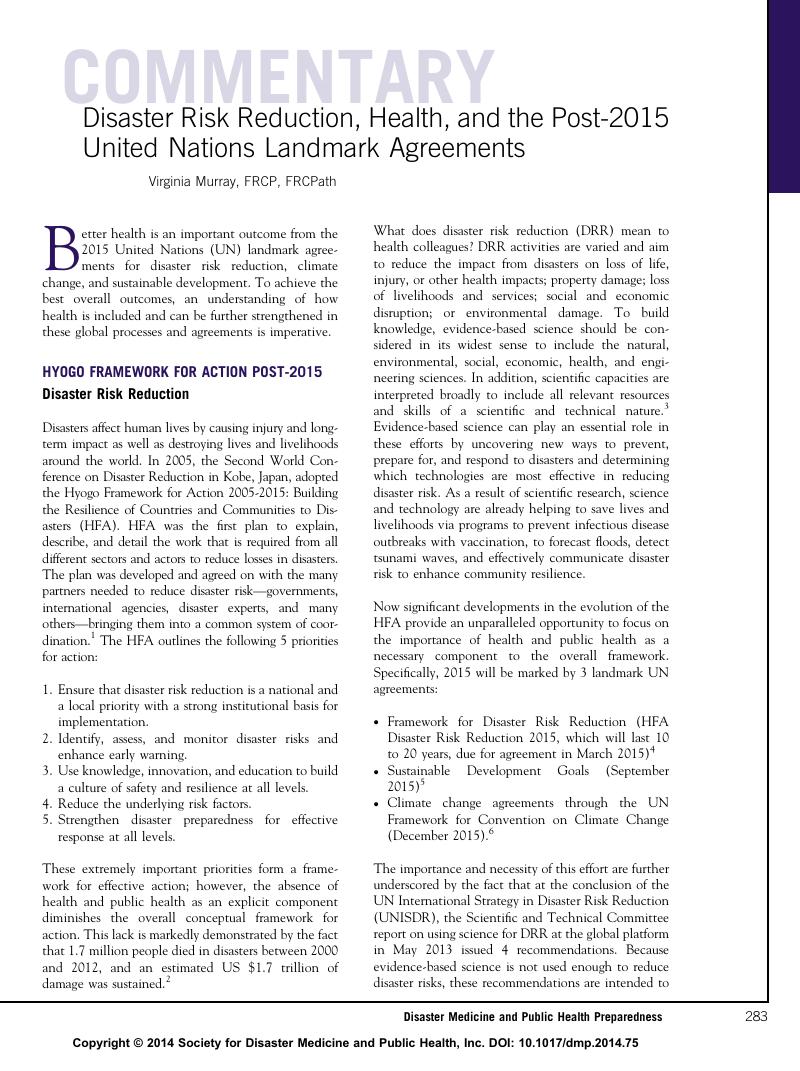Crossref Citations
This article has been cited by the following publications. This list is generated based on data provided by Crossref.
Murray, Virginia
Aitsi-Selmi, Amina
and
Blanchard, Kevin
2015.
The Role of Public Health Within the United Nations Post-2015 Framework for Disaster Risk Reduction.
International Journal of Disaster Risk Science,
Vol. 6,
Issue. 1,
p.
28.
Aitsi-Selmi, Amina
Murray, Virginia
Wannous, Chadia
Dickinson, Chloe
Johnston, David
Kawasaki, Akiyuki
Stevance, Anne-Sophie
and
Yeung, Tiffany
2016.
Reflections on a Science and Technology Agenda for 21st Century Disaster Risk Reduction.
International Journal of Disaster Risk Science,
Vol. 7,
Issue. 1,
p.
1.
Nomura, Shuhei
Parsons, Alexander J.Q.
Hirabayashi, Mayo
Kinoshita, Ryo
Liao, Yi
and
Hodgson, Susan
2016.
Social determinants of mid- to long-term disaster impacts on health: A systematic review.
International Journal of Disaster Risk Reduction,
Vol. 16,
Issue. ,
p.
53.
Lo, Sharon Tsoon Ting
Chan, Emily Ying Yang
Chan, Gloria Kwong Wai
Murray, Virginia
Abrahams, Jonathan
Ardalan, Ali
Kayano, Ryoma
and
Yau, Johnny Chung Wai
2017.
Health Emergency and Disaster Risk Management (Health-EDRM): Developing the Research Field within the Sendai Framework Paradigm.
International Journal of Disaster Risk Science,
Vol. 8,
Issue. 2,
p.
145.
Reifels, Lennart
2018.
Reducing the Future Risk of Trauma: On the Integration of Global Disaster Policy within Specific Health Domains and Established Fields of Practice.
International Journal of Environmental Research and Public Health,
Vol. 15,
Issue. 9,
p.
1932.
Banwell, Nicola
Rutherford, Shannon
Mackey, Brendan
and
Chu, Cordia
2018.
Towards Improved Linkage of Disaster Risk Reduction and Climate Change Adaptation in Health: A Review.
International Journal of Environmental Research and Public Health,
Vol. 15,
Issue. 4,
p.
793.
Ferentz, Larissa
Fonseca, Murilo Noli da
Pinheiro, Eduardo
and
Garcias, Carlos
2020.
A utilização de instrumentos globais para a avaliação da resiliência a desastres na saúde.
Saúde em Debate,
Vol. 44,
Issue. spe2,
p.
115.
Dewa, Ozius
Makoka, Donald
and
Ayo-Yusuf, Olalekan A.
2021.
Assessing Capacity and Implementation Status of the Disaster Risk Management Strategy for Health and Community Disaster Resilience in Malawi.
International Journal of Disaster Risk Science,
Vol. 12,
Issue. 5,
p.
673.
Ingrassia, Pier Luigi
Pigozzi, Luca
Bono, Mattia
Ragazzoni, Luca
and
Della Corte, Francesco
2021.
Use of Simulated Patients in Disaster Medicine Training: A Systematic Review.
Disaster Medicine and Public Health Preparedness,
Vol. 15,
Issue. 1,
p.
99.
Paterson, Shona K.
and
Guida, Kristen
2022.
Creating Resilient Futures.
p.
65.
Thomas, Justin
and
Terry, James P.
2022.
Containing COVID‐19 risk in the UAE: Mass quarantine, mental health, and implications for crisis management.
Risk, Hazards & Crisis in Public Policy,
Vol. 13,
Issue. 1,
p.
9.





